-

人教版新目标初中英语七年级下册What does he look like教案3篇
所需要用到的句子:Who is that?That is Jack. I like him.Why do you like him?I like him because he is interesting.Task 4: 设计理想中的人类Step one: 设计理想中的人类的外貌。把全班同学分成若干小组,学生可以边说边在纸上画出他们的模样。Step two: 设计理想中人类的性格。学生们可以把那些能描述性格的单词写在图画的旁边。Step three: 每组选出一名同学,其他同组同学提问,他作简单回答,并说明原因。所需用到的句子:What does he or she look like?He or she ...What is he or she like?He or she is ...Why?Because ...Task 5: 挑战性活动调查性格是天生的还是后天形成的,让每个同学回家去调查一下自己成长过程中性格是否有变化,具体是怎样的,为什么会这样? Teaching Aims:1. Enable students to have a general understanding of how to talk about people's physical appearance.2. Enable students to tackle some essential vocabularies and patterns about describing people. Provide them with necessary skills and methods.3. Create various chances for students to describe the persons they're familiar with, such as classmates, family members, teachers, idols, etc.
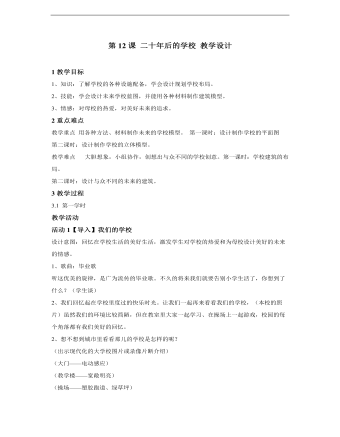
小学美术人教版六年级下册《第12课二十年后的学校》教学设计
2重点难点教学重点用各种方法、材料制作未来的学校模型。第一课时:设计制作学校的平面图第二课时:设计制作学校的立体模型。教学难点大胆想象,小组协作,创想出与众不同的学校创意。第一课时:学校建筑的布局。第二课时:设计与众不同的未来的建筑。3教学过程3.1 第一学时

部编版小学语文四年级下册第25课《两个铁球同时着地》优秀教案范文
1、齐读第三自然段。思考:亚里士多德讲过什么话?伽利略对这话是怎么看的?(亚里士多德说过:“两个铁球,一个10磅重,一个1磅重,同时从高处落下来,10磅重的一定先着地,速度是1磅重的10倍。”伽利略对这话产生了怀疑)2、伽利略为什么怀疑亚里士多德说的话?他是怎么想的?(“他想:如果这句话是正确的,……这怎么解释呢?”)3、伽利略的分析,是把亚里士多德的话当作两种假设,推出两个结论。这两个结论是什么?(①把一个10磅重,一个1磅重的两个铁球拴在一起,如果仍然看作是两个球,落下的速度应当比原来10磅重的铁球慢。②如果看做是一个整体,落下的速度,应当比原来10磅重的铁球快)4.这两个结果一样吗?是什么样的结果?(不—样,是相互矛盾的)5.根据同一句话,会推出两个相互矛盾的结果,所以伽利略认为这句话是靠不住的,值得怀疑。6,他打算怎么做?(用试验来证明不同重量铁球落地的情况)
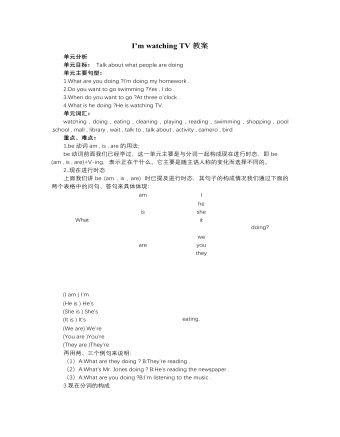
人教版新目标初中英语七年级下册I’m watching TV教案
单元分析单元目标: Talk about what people are doing 单元主要句型:1.What are you doing ?I’m doing my homework .2.Do you want to go swimming ?Yes , I do .3.When do you want to go ?At three o’clock .4.What is he doing ?He is watching TV. 单元词汇:watching , doing , eating , cleaning , playing , reading , swimming , shopping , pool ,school , mall , library , wait , talk to , talk about , activity , camero , bird 重点、难点:1.be动词am , is , are的用法;be动词前面我们已经学过,这一单元主要是与分词一起构成现在进行时态,即be (am , is , are)+V-ing,表示正在干什么。它主要是随主语人称的变化而选择不同的。2..现在进行时态上面我们讲be (am , is , are) 时已提及进行时态,其句子的构成情况我们通过下面的两个表格中的问句、答句来具体体现:3.现在分词的构成现在进行时态中be + V - ing 的构成中V-ing被称为现在分词,它的基本构成是动词原形+ing,但也有些特殊情况,下面分几类说明:(1)一般情况+ing如:read→reading,go→going,do→doing,look→looking,listen→listening,watch→watching.(2)以不发音的e结尾的词,去掉e,再加ing.如:write→writing,skate→skating,type→typing,wake→waking,make→making
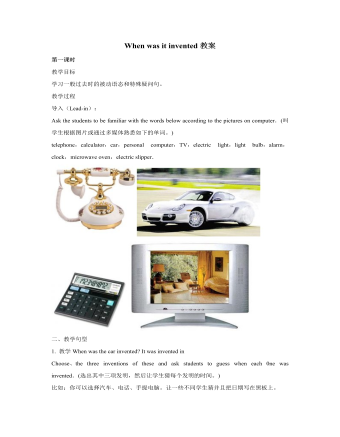
人教版新目标初中英语九年级下册When was it invented教案
二、教学 1a,1b.1.First the teacher asks the students what kind of fruit food and drink you like the best and writes down on the blackboard.教师问学生最喜欢什么水果和饮料并把它们写在黑板上。比如:potato chips,ice cream,tea,lemon,chocolate,oranges,salad,popcorn,pickle and so on.2.接着叫学生表达以上食物的味道,引出新单词——sweet,crispy,salty,sour,delicious,hot,awful,nice…并且完成lb教学内容通过此活动,以旧带新引入新单词。其目的是让学生自主学习新知识。 三、教学 2a,2b1.首先,听力前的brainstormFirst,Let students describe how potato chips taste and describe how helpful the potato chips.Then,ask:When and where were potato chips invented?Who were potato chips invented by?How were potato chips invented?(Let students guess according to the following key words.)Key words:by accident,customer,restaurant,by mistake.(说明:通过问题让学生对对话内容有整体了解,为听力练习做好准备;又培养学生的注意力,想像力,观察力。)
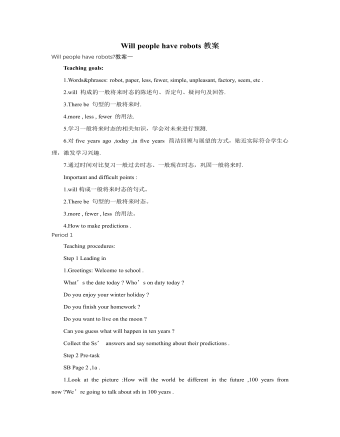
人教版新目标初中英语八年级下册Will people have robots教案
Teaching goals:1.Words&phrases: robot, paper, less, fewer, simple, unpleasant, factory, seem, etc .2.will 构成的一般将来时态的陈述句、否定句、疑问句及回答.3.There be 句型的一般将来时.4.more , less , fewer 的用法.5.学习一般将来时态的相关知识,学会对未来进行预测.6.对five years ago ,today ,in five years 简洁回顾与展望的方式,贴近实际符合学生心理,激发学习兴趣.7.通过时间对比复习一般过去时态、一般现在时态,巩固一般将来时.Important and difficult points :1.will构成一般将来时态的句式。2.There be 句型的一般将来时态。3.more , fewer , less 的用法。4.How to make predictions .Period 1Teaching procedures:Step 1 Leading in1.Greetings: Welcome to school .What’s the date today ? Who’s on duty today ?Do you enjoy your winter holiday ?Do you finish your homework ?Do you want to live on the moon ?Can you guess what will happen in ten years ?Collect the Ss’ answers and say something about their predictions .Step 2 Pre-taskSB Page 2 ,1a .1.Look at the picture :How will the world be different in the future ,100 years from now ?We’re going to talk about sth in 100 years .
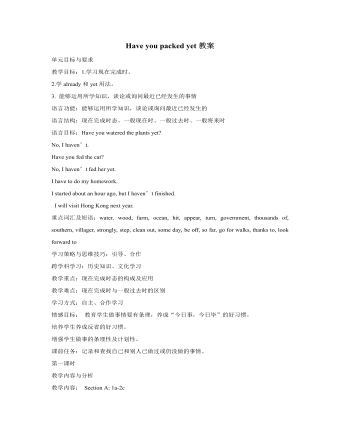
人教版新目标初中英语九年级下册Have you packed yet教案
教学目标:1.学习现在完成时。2.学already和yet用法。3. 能够运用所学知识,谈论或询问最近已经发生的事情语言功能:能够运用所学知识,谈论或询问最近已经发生的语言结构:现在完成时态、一般现在时、一般过去时、一般将来时语言目标:Have you watered the plants yet?No, I haven’t.Have you fed the cat?No, I haven’t fed her yet.I have to do my homework. I started about an hour ago, but I haven’t finished. I will visit Hong Kong next year.重点词汇及短语:water, wood, farm, ocean, hit, appear, turn, government, thousands of, southern, villager, strongly, step, clean out, some day, be off, so far, go for walks, thanks to, look forward to学习策略与思维技巧:引导、合作跨学科学习:历史知识、文化学习教学重点:现在完成时态的构成及应用教学难点:现在完成时与一般过去时的区别 学习方式:自主、合作学习 情感目标: 教育学生做事情要有条理,养成“今日事,今日毕”的好习惯。培养学生养成反省的好习惯。增强学生做事的条理性及计划性。课前任务:记录和查找自己和别人已做过或仍没做的事情。
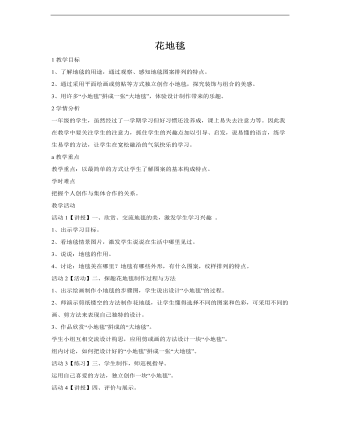
小学美术人教版一年级下册《第3课花地毯》教学设计
2学情分析一年级的学生,虽然经过了一学期学习但好习惯还没养成,课上易失去注意力等。因此我在教学中要关注学生的注意力,抓住学生的兴趣点加以引导、启发,说易懂的语言,练学生易学的方法,让学生在宽松融洽的气氛快乐的学习。a教学重点教学重点:以最简单的方式让学生了解图案的基本构成特点。学时难点把握个人创作与集体合作的关系。
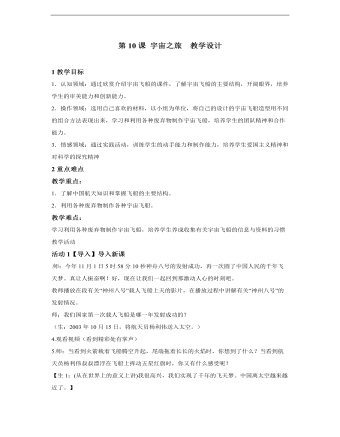
小学美术人教版六年级下册《第10课宇宙之旅》教学设计
2重点难点教学重点:1.了解中国航天知识和掌握飞船的主要结构。2.利用各种废弃物制作各种宇宙飞船。教学难点:学习利用各种废弃物制作宇宙飞船,培养学生养成收集有关宇宙飞船的信息与资料的习惯教学活动活动1【导入】导入新课.师:今年11月1日5时58分10秒神舟八号的发射成功,再一次圆了中国人民的千年飞天梦。真让人振奋啊!好,现在让我们一起回到那激动人心的时刻吧。教师播放在段有关“神州八号”载人飞船上天的影片,在播放过程中讲解有关“神州八号”的发射情况。
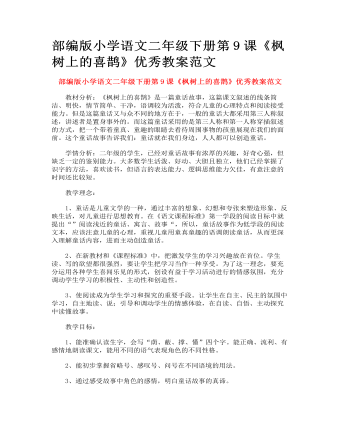
部编版小学语文二年级下册第9课《枫树上的喜鹊》优秀教案范文
教材分析:《枫树上的喜鹊》是一篇童话故事,这篇课文叙述的线条简洁、明快,情节简单、干净,语调较为活泼,符合儿童的心理特点和阅读接受能力。但是这篇童话又与众不同的地方在于,一般的童话大都采用第三人称叙述,讲述者是置身事外的。而这篇童话采用的是第三人称和第一人称穿插叙述的方式,把一个带着童真、童趣的眼睛去看待周围事物的孩童展现在我们的面前。这个童话故事告诉我们:童话就在我们身边,人人都可以创造童话。 学情分析:二年级的学生,已经对童话故事有浓厚的兴趣,好奇心强,但缺乏一定的鉴别能力。大多数学生活泼、好动、大胆且独立,他们已经掌握了识字的方法,喜欢读书,但语言的表达能力、逻辑思维能力欠佳,有意注意的时间还比较短。
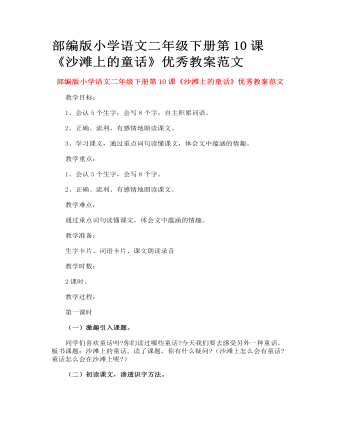
部编版小学语文二年级下册第10课《沙滩上的童话》优秀教案范文
(1)指名读。评议。用自己体会的感情比赛朗读。(抓住“趴”、“四面八方”、“挖呀、挖呀”、“欢呼”;“终于”、“一……就”等词语来朗读体会小朋友心地纯善。“我们欢呼着胜利,欢呼着炸死了魔王,欢呼着救出了公主。”排比句写出了孩子们战胜邪恶、赢得胜利的无比兴奋的心情。指导读好。)(2)孩子们的故事是真的吗?妈妈为什么会被我们当作是公主?听老师老师朗读4、5自然段,学生思考。(我们太高兴了,我们被当时的情景感染了。)妈妈怎么会出现在身后?(结合第一自然段的“偷偷”来理解:“偷偷”说明我们怕大人知道批评我们贪玩,制止我们去玩。于是只好不告诉大人,私自去玩,还自以为大人不知道。可事实上,妈妈或许见我们玩得很高兴有意思,并没有责怪我们。只是见我们没按时回家有点担心我们,便找来了。引导学生充分说,来体会父母对孩子的爱。)

部编版小学语文四年级下册第27课《鱼游到了纸上》优秀教案范文
1.想想课文讲了一件什么事?“鱼游到了纸上”的意思是什么?(“我”去玉泉观鱼,认识了一位残疾青年,他每个星期天都来这里画金鱼。“鱼游到了纸上”意思是说这位青年画的金鱼十分形象生动,像活的那样在纸上游动。学生可以从整体感知课文内容,只要大致说出课文讲了一件什么事就行了。)2.你是怎么知道这位青年是聋哑人?找出课文中的有关语句。(“从来不说一句话”“没有任何反应”,和他胸前佩戴的“福利工厂”的厂徽,可以看出他是一位聋哑青年。如果是会说话的人,不可能从来不说一句话;如果是听得见的人,那么在众人的赞叹、议论声中,不可能“没有任何反应”;“福利工厂”一般是专为残疾人开办的工厂。)
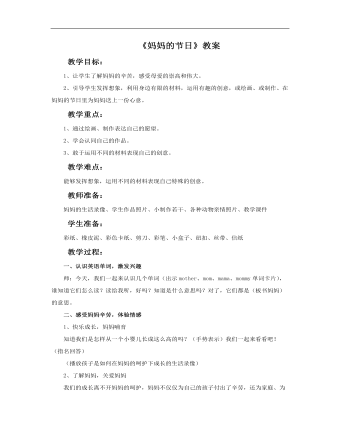
小学美术人教版一年级下册《第12课妈妈的节日》教案
教学重点:1、通过绘画、制作表达自己的愿望。2、学会认同自己的作品。3、敢于运用不同的材料表现自己的创意。教学难点:能够发挥想象,运用不同的材料表现自己特殊的创意。教师准备:妈妈的生活录像、学生作品照片、小制作若干、各种动物亲情照片、教学课件学生准备:彩纸、橡皮泥、彩色卡纸、剪刀、彩笔、小盒子、纽扣、丝带、信纸

人教版高中政治必修4第三课时代精神的精华教案
此探究活动的目的是为了说明马克思主义哲学是科学完整的体系。在探究活动时可以首先向学生简单介绍西方哲学的发展历史,使学生对马克思主义哲学在整个西方哲学中的位置和地位有个大致了解。离开了这个大的背景,学生对马克思主义哲学就容易摸不着头绪。马克思主义哲学之前的唯物主义的局限性表现在:古代朴素的带有辩证法性质的唯物主义主要是追问世界的本原问题,这时的哲学缺乏近代科学作为基础,因此它更多的是一种猜测。它虽然看到了世界的联系和变化,但它还无法理解联系和变化背后的基础和原因。近代形而上学的唯物主义主要是追问人的认识问题,即人的认识的来源是什么,是什么保证人的认识的可靠性。但它对人的认识问题的解决主要是立足于对世界的一种直观观察,认为人的认识来源于对世界的直观的、机械的反映。它不理解人的实践活动,不理解人是在改造世界的过程中认识世界,人的认识是在实践基础上的能动反映。
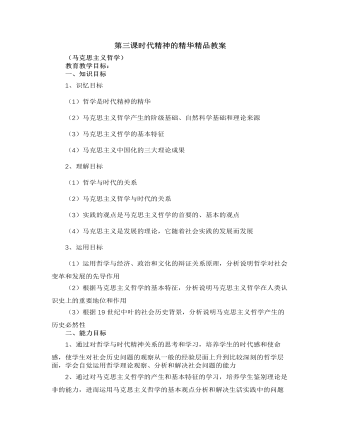
人教版高中政治必修4第三课时代精神的精华精品教案
教学重点难点:1、哲学与时代的关系(重点)2、马克思主义哲学是科学的世界观和方法论(重点)3、实践的观点在马克思主义哲学中占有重要的地位和作用(重点、难点)4、马克思主义中国化的三大理论成果(重点)教学课时安排:3课时【导入新课】德国人和中国人一同坐火车从德国的法兰克福去巴黎。途中上来一位客人,这位客人将手里端着的鱼缸放在空座上。德国人开始发问:“您能告诉我这鱼的名称吗?它在生物学上属于什么类别?它在科学上的意义又是什么?”中国人则问:“这种鱼是红烧好吃,还是清蒸更好吃一点?”这一故事体现了中西方思维方式的差异,这一差异也折射出中西方哲学上的差异。西方哲学起源于古希腊哲学,表现为对各种现象之后的原因的关注和对确定性的追求,强调理性认知。中国哲学主要是儒家哲学,主要集中在政治伦理方面,表现为对人的关怀和规范,强调感性体验。中西方哲学为何出现这样的差异?哲学与政治、经济有怎样的关系?

新人教版高中英语选修2Unit 2 Learning about Language教学设计
The activity theme of this section is to design various activities around the key words in the first text. Therefore, the activities require students to pay attention to the spelling of words. On the other hand, let students grasp the meaning of words more accurately through sentences and short texts. This kind of teaching design also helps to improve the ability of using English thinking.1. Cultivating students' ability to use word formation to induce and memorize vocabulary, and the ability to use lexical chunks to express meaning.2. Guide the students to think independently and use the correct form of words to complete sentences3. Cultivate students' habit of using lexical chunks to express language completely, guide students to draw words in sentences quickly, pay attention to word collocation, so as to accumulate more authentic expressions4. Instruct students to create sentences with the chunks.1. Enable students to use the language points in the real situation or specific contexts flexibly and appropriately.2. Guiding the Ss to use unit topic words and the sentence patterns in a richer context.Step1: Think of a word that best fits each definition.1. to remember sth2.to accept, admit, or recognize sth or the truth/existence of sth3. the process of changing sth or yourself to suit a new situation4 .to make sb feel less worried or unhappy5. a strong desire to achieve sth

新人教版高中英语选修2Unit 2 Reading for writing教学设计
The theme of this section is to express people's views on studying abroad. With the continuous development of Chinese economic construction, especially the general improvement of people's living standards, the number of Chinese students studying abroad at their own expense is on the rise. Many students and parents turn their attention to the world and regard studying abroad as an effective way to improve their quality, broaden their horizons and master the world's advanced scientific knowledge, which is very important for the fever of going abroad. Studying abroad is also an important decision made by a family for their children. Therefore, it is of great social significance to discuss this issue. The theme of this section is the column discussion in the newspaper: the advantages and disadvantages of studying abroad. The discourse is about two parents' contribution letters on this issue. They respectively express their own positions. One thinks that the disadvantages outweigh the advantages, and the other thinks that the advantages outweigh the disadvantages. The two parents' arguments are well founded and logical. It is worth noting that the two authors do not express their views on studying abroad from an individual point of view, but from a national or even global point of view. These two articles have the characteristics of both letters and argumentative essays1.Guide the students to read these two articles, and understand the author's point of view and argument ideas2.Help the students to summarize the structure and writing methods of argumentative writing, and guides students to correctly understand the advantages and disadvantages of studying abroad3.Cultivate students' ability to analyze problems objectively, comprehensively and deeply

新人教版高中英语选修2Unit 2 Using langauge-Listening教学设计
? B: Absolutely! Getting involved with Chinese cultural activities there definitely helped a lot. I got to practice my Chinese on a daily basis, and I could learn how native Chinese speakers spoke.? A: What do you feel is your biggest achievement?? B: Learning Chinese characters! I have learnt about 1,500 so far. When I first started, I didn't think it was even going to be possible to learn so many, but now I find that I can read signs, menus, and even some easy newspaper articles.? A: What are you most keen on?? B: I've really become keen on learning more about the Chinese culture, in particular Chinese calligraphy. As I have learnt Chinese characters, I have developed a great appreciation for their meaning. I want to explore Chinese characters by learning how to write them in a more beautiful way. ? A: Finally, what do you want to say to anyone interested in learning Chinese?? I have really become keen on learning more about the Chinese culture, in particular Chinese Calligraphy. As I have learnt Chinese character, I have developed a great appreciation for their meaning. I want to explore Chinese characters by learning how to write them in a more beautiful way.? A: Finally, what do you want to say to anyone interested in learning Chinese?? B: I'd say, give it a shot! While some aspects may be difficult, it is quite rewarding and you will be happy that you tried.? A: Thanks for your time. ? B:You're welcome.

新人教版高中英语选修2Unit 2 Reading and thinking教学设计
Her tutor told her to acknowledge __________ other people had said if she cited their ideas, and advised her _______(read) lots of information in order to form __________wise opinion of her own.Now halfway __________ her exchange year, Xie Lei felt much more at home in the UK. She said __________ (engage) in British culture had helped and that she had been__________ (involve) in social activities. She also said while learning about business, she was acting as a cultural messenger __________(build) a bridge between the two countries. keys:Xie Lei, a 19yearold Chinese student, said goodbye to her family and friends in China and boarded (board) a plane for London six months ago in order to get a business qualification. She was ambitious(ambition) to set up a business after graduation. It was the first time that she had left (leave) home.At first, Xie Lei had to adapt to life in a different country. She chose to live with a host family, who can help with her adaptation (adapt) to the new culture. When she missed home, she felt comforted (comfort) to have a second family. Also Xie Lei had to satisfy academic requirements. Her tutor told her to acknowledge what other people had said if she cited their ideas, and advised her to read lots of information in order to form a wise opinion of her own.Now halfway through her exchange year, Xie Lei felt much more at home in the UK. She said engaging (engage) in British culture had helped and that she had been involved (involve) in social activities. She also said while learning about business, she was acting as a cultural messenger building a bridge between the two countries.
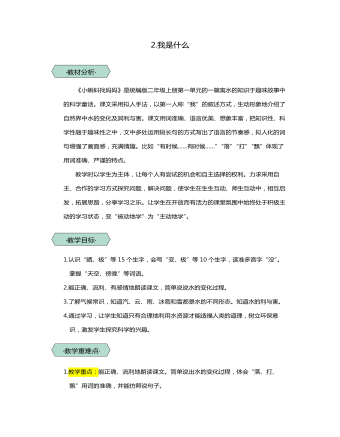
统编版二年级语文上第2课我是什么教学设计教案
《小蝌蚪找妈妈》是统编版二年级上册第一单元的一篇寓水的知识于趣味故事中的科学童话。课文采用拟人手法,以第一人称“我”的叙述方式,生动形象地介绍了自然界中水的变化及其利与害。课文用词准确、语言优美、想象丰富,把知识性、科学性融于趣味性之中,文中多处运用短长句的方式写出了语言的节奏感,拟人化的词句增强了画面感,充满情趣。比如“有时候……有时候……”“落”“打”“飘”体现了用词准确、严谨的特点。教学时以学生为主体,让每个人有尝试的机会和自主选择的权利。力求采用自主、合作的学习方式探究问题,解决问题,使学生在生生互动、师生互动中,相互启发,拓展思路,分享学习之乐。让学生在开放而有活力的课堂氛围中始终处于积极主动的学习状态,变“被动地学”为“主动地学”。 ·教学目标· 1.认识“晒、极”等15个生字,会写“变、极”等10个生字,读准多音字“没”。掌握“天空、傍晚”等词语。2.能正确、流利、有感情地朗读课文,简单说说水的变化过程。3.了解气候常识,知道汽、云、雨、冰雹和雪都是水的不同形态。知道水的利与害。4.通过学习,让学生知道只有合理地利用水资源才能造福人类的道理,树立环保意识,激发学生探究科学的兴趣。 ·教学重难点· 1.教学重点:能正确、流利地朗读课文。简单说出水的变化过程,体会“落、打、飘”用词的准确,并能仿照说句子。2.教学难点:了解气候常识,知道汽、云、雨、冰雹和雪都是水的不同形态。知道水的利与害。

